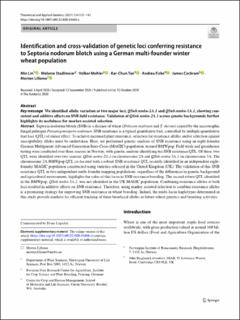| dc.contributor.author | Lin, Min | |
| dc.contributor.author | Stadlmeier, Melanie | |
| dc.contributor.author | Mohler, Volker | |
| dc.contributor.author | Tan, Kar-Chun | |
| dc.contributor.author | Ficke, Andrea | |
| dc.contributor.author | Cockram, James | |
| dc.contributor.author | Lillemo, Morten | |
| dc.date.accessioned | 2021-02-04T08:40:10Z | |
| dc.date.available | 2021-02-04T08:40:10Z | |
| dc.date.created | 2020-12-02T12:36:22Z | |
| dc.date.issued | 2020-10-12 | |
| dc.identifier.citation | Theoretical and Applied Genetics. 2020, 134 125-142. | en_US |
| dc.identifier.issn | 0040-5752 | |
| dc.identifier.uri | https://hdl.handle.net/11250/2726088 | |
| dc.description.abstract | Key message We identifed allelic variation at two major loci, QSnb.nmbu-2A.1 and QSnb.nmbu-5A.1, showing consistent and additive efects on SNB feld resistance. Validation of QSnb.nmbu-2A.1 across genetic backgrounds further highlights its usefulness for marker-assisted selection. Abstract Septoria nodorum blotch (SNB) is a disease of wheat (Triticum aestivum and T. durum) caused by the necrotrophic fungal pathogen Parastagonospora nodorum. SNB resistance is a typical quantitative trait, controlled by multiple quantitative trait loci (QTL) of minor efect. To achieve increased plant resistance, selection for resistance alleles and/or selection against susceptibility alleles must be undertaken. Here, we performed genetic analysis of SNB resistance using an eight-founder German Multiparent Advanced Generation Inter-Cross (MAGIC) population, termed BMWpop. Field trials and greenhouse testing were conducted over three seasons in Norway, with genetic analysis identifying ten SNB resistance QTL. Of these, two QTL were identifed over two seasons: QSnb.nmbu-2A.1 on chromosome 2A and QSnb.nmbu-5A.1 on chromosome 5A. The chromosome 2A BMWpop QTL co-located with a robust SNB resistance QTL recently identifed in an independent eightfounder MAGIC population constructed using varieties released in the United Kingdom (UK). The validation of this SNB resistance QTL in two independent multi-founder mapping populations, regardless of the diferences in genetic background and agricultural environment, highlights the value of this locus in SNB resistance breeding. The second robust QTL identifed in the BMWpop, QSnb.nmbu-5A.1, was not identifed in the UK MAGIC population. Combining resistance alleles at both loci resulted in additive efects on SNB resistance. Therefore, using marker assisted selection to combine resistance alleles is a promising strategy for improving SNB resistance in wheat breeding. Indeed, the multi-locus haplotypes determined in this study provide markers for efcient tracking of these benefcial alleles in future wheat genetics and breeding activities. | en_US |
| dc.language.iso | eng | en_US |
| dc.publisher | Springer Nature | en_US |
| dc.rights | Navngivelse 4.0 Internasjonal | * |
| dc.rights.uri | http://creativecommons.org/licenses/by/4.0/deed.no | * |
| dc.title | Identification and cross-validation of genetic loci conferring resistance to Septoria nodorum blotch using a German multi-founder winter wheat population | en_US |
| dc.type | Peer reviewed | en_US |
| dc.type | Journal article | en_US |
| dc.description.version | publishedVersion | en_US |
| dc.rights.holder | © The Author(s) 2020 | en_US |
| dc.source.pagenumber | 125-142 | en_US |
| dc.source.volume | 134 | en_US |
| dc.source.journal | Theoretical and Applied Genetics | en_US |
| dc.identifier.doi | 10.1007/s00122-020-03686-x | |
| dc.identifier.cristin | 1855280 | |
| dc.relation.project | Norges forskningsråd: 251894 | en_US |
| cristin.ispublished | true | |
| cristin.fulltext | original | |
| cristin.qualitycode | 2 | |

